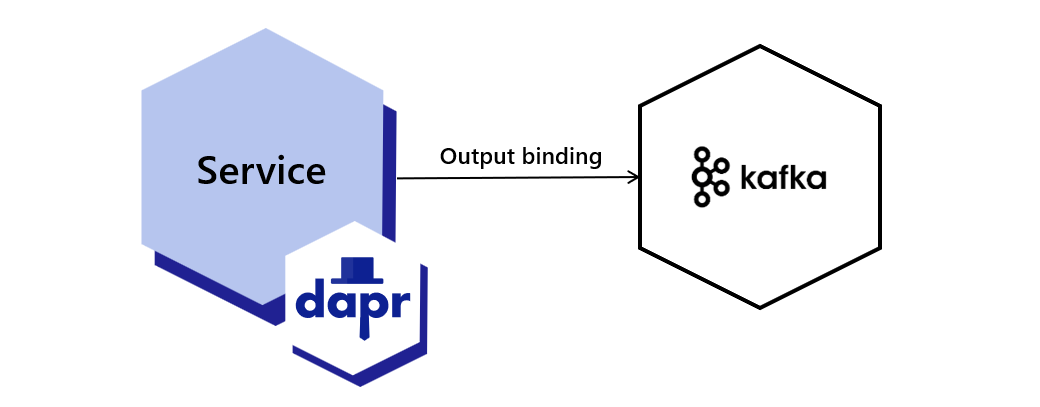操作指南:使用输出绑定与外部资源交互
通过输出绑定调用外部系统
使用输出绑定,您可以与外部资源进行交互。在调用请求中,您可以发送可选的负载和元数据。

本指南以Kafka绑定为例。您可以从绑定组件列表中选择您偏好的绑定规范。在本指南中:
- 示例中调用了
/binding端点,使用checkout作为要调用的绑定名称。 - 负载放在必需的
data字段中,可以是任何JSON可序列化的值。 operation字段指定绑定需要执行的操作。例如,Kafka绑定支持create操作。- 您可以查看每个输出绑定支持的操作(特定于每个组件)。
注意
如果您还没有尝试过,请尝试绑定快速入门,以快速了解如何使用bindings API。创建绑定
创建一个binding.yaml文件,并将其保存到应用程序目录中的components子文件夹中。
创建一个名为checkout的新绑定组件。在metadata部分中,配置以下与Kafka相关的属性:
- 您将发布消息的主题
- 代理
在创建绑定组件时,指定绑定的支持direction。
使用dapr run的--resources-path标志指向您的自定义资源目录。
apiVersion: dapr.io/v1alpha1
kind: Component
metadata:
name: checkout
spec:
type: bindings.kafka
version: v1
metadata:
# Kafka代理连接设置
- name: brokers
value: localhost:9092
# 消费者配置:主题和消费者组
- name: topics
value: sample
- name: consumerGroup
value: group1
# 发布者配置:主题
- name: publishTopic
value: sample
- name: authRequired
value: false
- name: direction
value: output
要将以下binding.yaml文件部署到Kubernetes集群中,运行kubectl apply -f binding.yaml。
apiVersion: dapr.io/v1alpha1
kind: Component
metadata:
name: checkout
spec:
type: bindings.kafka
version: v1
metadata:
# Kafka代理连接设置
- name: brokers
value: localhost:9092
# 消费者配置:主题和消费者组
- name: topics
value: sample
- name: consumerGroup
value: group1
# 发布者配置:主题
- name: publishTopic
value: sample
- name: authRequired
value: false
- name: direction
value: output
发送事件(输出绑定)
下面的代码示例利用Dapr SDK在运行的Dapr实例上调用输出绑定端点。
//依赖项
using System;
using System.Collections.Generic;
using System.Net.Http;
using System.Net.Http.Headers;
using System.Threading.Tasks;
using Dapr.Client;
using Microsoft.AspNetCore.Mvc;
using System.Threading;
//代码
namespace EventService
{
class Program
{
static async Task Main(string[] args)
{
string BINDING_NAME = "checkout";
string BINDING_OPERATION = "create";
while(true)
{
System.Threading.Thread.Sleep(5000);
Random random = new Random();
int orderId = random.Next(1,1000);
using var client = new DaprClientBuilder().Build();
//使用Dapr SDK调用输出绑定
await client.InvokeBindingAsync(BINDING_NAME, BINDING_OPERATION, orderId);
Console.WriteLine("发送消息: " + orderId);
}
}
}
}
//依赖项
import io.dapr.client.DaprClient;
import io.dapr.client.DaprClientBuilder;
import io.dapr.client.domain.HttpExtension;
import org.springframework.boot.autoconfigure.SpringBootApplication;
import org.slf4j.Logger;
import org.slf4j.LoggerFactory;
import java.util.Random;
import java.util.concurrent.TimeUnit;
//代码
@SpringBootApplication
public class OrderProcessingServiceApplication {
private static final Logger log = LoggerFactory.getLogger(OrderProcessingServiceApplication.class);
public static void main(String[] args) throws InterruptedException{
String BINDING_NAME = "checkout";
String BINDING_OPERATION = "create";
while(true) {
TimeUnit.MILLISECONDS.sleep(5000);
Random random = new Random();
int orderId = random.nextInt(1000-1) + 1;
DaprClient client = new DaprClientBuilder().build();
//使用Dapr SDK调用输出绑定
client.invokeBinding(BINDING_NAME, BINDING_OPERATION, orderId).block();
log.info("发送消息: " + orderId);
}
}
}
#依赖项
import random
from time import sleep
import requests
import logging
import json
from dapr.clients import DaprClient
#代码
logging.basicConfig(level = logging.INFO)
BINDING_NAME = 'checkout'
BINDING_OPERATION = 'create'
while True:
sleep(random.randrange(50, 5000) / 1000)
orderId = random.randint(1, 1000)
with DaprClient() as client:
#使用Dapr SDK调用输出绑定
resp = client.invoke_binding(BINDING_NAME, BINDING_OPERATION, json.dumps(orderId))
logging.basicConfig(level = logging.INFO)
logging.info('发送消息: ' + str(orderId))
//依赖项
import (
"context"
"log"
"math/rand"
"time"
"strconv"
dapr "github.com/dapr/go-sdk/client"
)
//代码
func main() {
BINDING_NAME := "checkout";
BINDING_OPERATION := "create";
for i := 0; i < 10; i++ {
time.Sleep(5000)
orderId := rand.Intn(1000-1) + 1
client, err := dapr.NewClient()
if err != nil {
panic(err)
}
defer client.Close()
ctx := context.Background()
//使用Dapr SDK调用输出绑定
in := &dapr.InvokeBindingRequest{ Name: BINDING_NAME, Operation: BINDING_OPERATION , Data: []byte(strconv.Itoa(orderId))}
err = client.InvokeOutputBinding(ctx, in)
log.Println("发送消息: " + strconv.Itoa(orderId))
}
}
//依赖项
import { DaprClient, CommunicationProtocolEnum } from "@dapr/dapr";
//代码
const daprHost = "127.0.0.1";
(async function () {
for (var i = 0; i < 10; i++) {
await sleep(2000);
const orderId = Math.floor(Math.random() * (1000 - 1) + 1);
try {
await sendOrder(orderId)
} catch (err) {
console.error(e);
process.exit(1);
}
}
})();
async function sendOrder(orderId) {
const BINDING_NAME = "checkout";
const BINDING_OPERATION = "create";
const client = new DaprClient({
daprHost,
daprPort: process.env.DAPR_HTTP_PORT,
communicationProtocol: CommunicationProtocolEnum.HTTP,
});
//使用Dapr SDK调用输出绑定
const result = await client.binding.send(BINDING_NAME, BINDING_OPERATION, orderId);
console.log("发送消息: " + orderId);
}
function sleep(ms) {
return new Promise(resolve => setTimeout(resolve, ms));
}
您还可以使用HTTP调用输出绑定端点:
curl -X POST -H 'Content-Type: application/json' http://localhost:3601/v1.0/bindings/checkout -d '{ "data": 100, "operation": "create" }'
观看此视频以了解如何使用双向输出绑定。